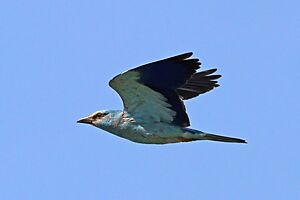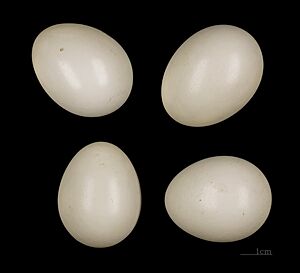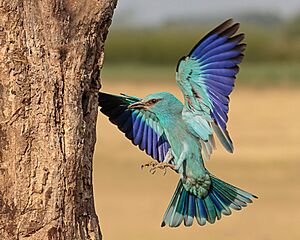European roller facts for kids
Quick facts for kids European roller |
|
|---|---|
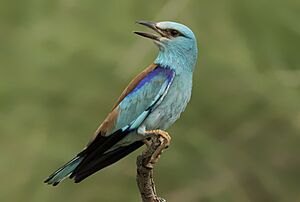 |
|
| Conservation status | |
| Scientific classification | |
| Genus: |
Coracias
|
| Species: |
garrulus
|
| Subspecies | |
|
|
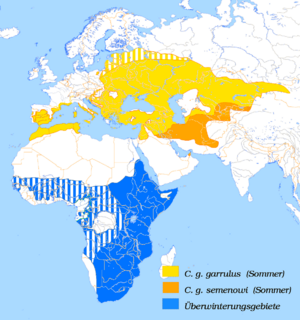 |
|
| Distribution of the European roller summer C. g. garrulus summer C. g. semenowi winter | |
The European roller (Coracias garrulus) is a beautiful bird known for its bright blue feathers. It's the only type of roller bird that nests in Europe. These birds also live in the Middle East, Central Asia, and North Africa. When winter comes, they fly all the way to southern Africa. They like places with trees and bushes, but not wide-open plains. European rollers usually build their nests inside holes in trees.
Contents
What is a European Roller?
The European roller is a medium-sized bird. It belongs to a group of birds called rollers. Most rollers live in warmer parts of the world, especially south of the Sahara Desert. They are known for their bright colors and strong, hooked beaks.
Naming the European Roller
The European roller was first officially described in 1758. A Swedish scientist named Carl Linnaeus gave it its scientific name, Coracias garrulus. The name Coracias comes from a Greek word for a type of crow. The word garrulus comes from Latin and means 'chattering'. This refers to the bird's calls.
You might also hear this bird called the blue roller, common roller, or Eurasian roller.
Roller Family Tree
Scientists have studied the family connections of the European roller. They found that it is most closely related to the Abyssinian roller. These two birds, along with the lilac-breasted roller, are very similar.
The phylogenetic relationships among the Coracias species are shown below, from the molecular study by Johansson et al. (2018)
| Coracias |
|
||||||||||||||||||||||||||||||||||||||||||||||||
Different Kinds of European Rollers
There are two main types, or subspecies, of the European roller:
- Western European roller (C. g. garrulus): This type lives in North Africa, southern Europe, and east to Siberia.
- Eastern European roller (C. g. semenowi): This type is also called the Kashmir roller. It lives from Iraq and Iran east to China.
How to Identify a European Roller
The European roller is a sturdy bird. It's about the same size as a Eurasian jay. It grows to be about 29 to 32 centimeters (11 to 13 inches) long. Its wingspan is about 52 to 58 centimeters (20 to 23 inches).
This bird is mostly bright blue. It has an orange-brown back. When it flies, you can see its brilliant blue feathers. Its wingtips are black. Male and female rollers look very similar. Young rollers are not as brightly colored as the adults.
Roller Flight and Sounds
The European roller has a special way of flying. It twists and turns in the air. This acrobatic flight is how it got its name. Its call sounds harsh, a bit like a crow. It makes loud noises when it feels worried.
Where European Rollers Live
The European roller prefers warmer places. The western type breeds in North Africa and parts of Europe. It also lives eastwards into Siberia. The eastern type breeds from Iraq to China.
Changing Homes
In the past, European rollers lived in more places in Europe. But their numbers have gone down in the north and west. For example, they no longer nest in Sweden or Germany.
Winter Travels
European rollers are migratory birds. This means they fly long distances for winter. They spend winter in Africa, south of the Sahara Desert. Some populations fly to Africa through India.
Favorite Places to Live
Rollers like warm, dry, open areas with scattered trees. They prefer lower lands. However, they can live up to 1,000 meters (3,300 feet) high in Europe. In Morocco, they can live up to 2,000 meters (6,600 feet) high.
They love oak and pine forests with open spaces. Farms, orchards, and areas with mixed plants are also good homes. In Africa, they use similar dry, open lands with trees. They usually nest in tree holes during winter.
The Amazing Roller Migration
Scientists use small trackers to follow rollers. This helps them learn about their long journeys. Rollers from southwestern Europe fly to southwestern Africa. Birds from France and northern Spain fly straight across the Sahara Desert. Birds from Portugal and southern Spain fly along the West African coast.
Rollers from eastern Europe also spend winter in southern Africa. They go to places like Zambia, Zimbabwe, and Botswana. An area south of the Sahara Desert, near Lake Chad, is important. Many rollers stop there in autumn to rest and eat.
Some northern rollers, like those from Latvia, fly north in spring. They travel through the Arabian Peninsula. Rollers from different places use different wintering spots. But these spots often overlap. It seems that rollers from breeding areas further east tend to winter further east.
Roller Life and Habits
When a European roller chick is in its nest, it has a special defense. If a predator comes close, the chick can spit out a smelly orange liquid. This helps to scare the predator away. The smell also tells the parents that something is wrong when they return to the nest.
Nesting and Raising Young
European rollers usually build their nests in natural holes in trees. Sometimes they use holes made by woodpeckers. The nest is usually about 5 to 10 meters (16 to 33 feet) above the ground. They might also use holes in rocks or buildings. Sometimes, they even dig a hole in a sandy bank.
The nest itself has no lining. The female roller lays 2 to 6 smooth, white, shiny eggs. She lays one egg every two or three days. Both parents help to warm the eggs, but the female does most of it. The eggs hatch after 17 to 19 days.
Both parents care for the young birds. The male often brings food to the female, who then feeds the chicks. The young rollers leave the nest after 26 to 27 days. Rollers usually raise only one group of chicks each year. If their first eggs are lost, they might lay new ones. Most European rollers start breeding when they are two years old.
The oldest European roller found lived for 9 years and 2 months. This was a bird found in Poland.
What Rollers Eat
Rollers often sit on trees, posts, or wires. They watch for their food from these high spots. They eat large insects, small reptiles, rodents, and frogs. Adult rollers mostly eat beetles. Young rollers in the nest mostly eat Orthoptera, like grasshoppers and bush crickets.
Protecting the European Roller
The European roller lives in many parts of Europe and Asia. There are an estimated 159,000 to 330,000 breeding birds in Europe. When you add birds from Asia, the total is about 277,000 to 660,000 rollers.
Why Numbers are Declining
The number of European rollers has been going down quite fast in many areas. Because of this, they were once listed as "near threatened" in 2005. However, in 2015, their status was changed to "least concern." This means scientists felt the decline was not as urgent as before. Still, the European population dropped by 25 percent between 1990 and 2000. Numbers have fallen the most in northern areas. For example, there are no longer any breeding rollers in Estonia.
Main Threats
There are several reasons why roller numbers are declining:
- Hunting: Some rollers are hunted during their migration around the Mediterranean Sea. Thousands might be killed for food in places like Oman.
- Farming Changes: Modern farming often removes trees and hedges. These are important places for rollers to nest and hunt.
- Pesticides: The use of chemicals called pesticides reduces the number of insects. This means less food for the rollers.
To help rollers, people can put up nest boxes where there is plenty of food. But in other places, it's more important to bring back their natural hunting grounds.




